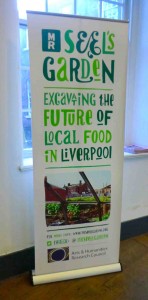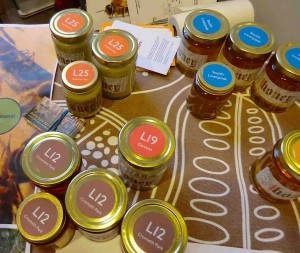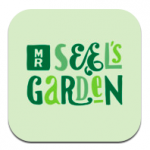 I spent a wonderful Sunday in January at the Bluecoat Arts Centre in Liverpool with academics and community members of this Connected Communities project. It was a day-long showcase of the project’s activities, and the overwhelming feeling I came away with was one of the warmth between the people involved, and a real enthusiasm to share their knowledge, skills, memories. In terms of community it really does feel like a model project.
I spent a wonderful Sunday in January at the Bluecoat Arts Centre in Liverpool with academics and community members of this Connected Communities project. It was a day-long showcase of the project’s activities, and the overwhelming feeling I came away with was one of the warmth between the people involved, and a real enthusiasm to share their knowledge, skills, memories. In terms of community it really does feel like a model project.
While there I bought a jar of local honey—now, I always do that, wherever I am. But I don’t usually get a choice of different honeys with labels on the jars informing me of the various city postcodes each jar has come from. And introduced by a local beekeeper who has stories about all the other Merseyside beekeepers and their products. And with a map on the table pointing to the location of each set of hives explaining the nearby dominant plants and gardens that might explain L25’s taste and texture as opposed to Liverpool 12’s, say. A sweet and tasty postcode lottery, illuminated, in a jar. Can I just say it: foodtastic.
 I uploaded an app to my phone, so that I could scan the barcodes of supermarket food products. Then the phone screen shows a short paragraph telling the history of that particular product, as uncovered by some of the community researchers with the help of the project’s museum archivist. (Neatly, laying bare the local within global, the app only works within a 20-mile radius of Liverpool.) Rose’s lime cordial, for instance, came to the UK first from the USA on a ship that unloaded at Liverpool docks in 1912.
I uploaded an app to my phone, so that I could scan the barcodes of supermarket food products. Then the phone screen shows a short paragraph telling the history of that particular product, as uncovered by some of the community researchers with the help of the project’s museum archivist. (Neatly, laying bare the local within global, the app only works within a 20-mile radius of Liverpool.) Rose’s lime cordial, for instance, came to the UK first from the USA on a ship that unloaded at Liverpool docks in 1912.
 I listened to local people tell their memories of food and farming in the city, with wit and confidence. And I saw those memories mapped on to old Ordnance Survey maps of sections of Liverpool, that information in turn transferred to a Google Map-style device on the Mr Seel’s Garden website, so you can see how urban land use, horticulture, animal husbandry has developed, disappeared and reappeared across the cityscape. Academic and local history, food production, gardening, memory, archive and map work, urban identity, digital media … and more …
I listened to local people tell their memories of food and farming in the city, with wit and confidence. And I saw those memories mapped on to old Ordnance Survey maps of sections of Liverpool, that information in turn transferred to a Google Map-style device on the Mr Seel’s Garden website, so you can see how urban land use, horticulture, animal husbandry has developed, disappeared and reappeared across the cityscape. Academic and local history, food production, gardening, memory, archive and map work, urban identity, digital media … and more …
